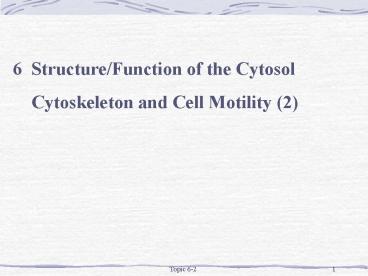6 StructureFunction of the Cytosol - PowerPoint PPT Presentation
1 / 22
Title:
6 StructureFunction of the Cytosol
Description:
Mostly extremely labile. Non-covalent bonds. More stable forms. Stabilized by. MAPs ... Mostly extremely labile. GTP required for assembly. GTP bound to b-tubulin ... – PowerPoint PPT presentation
Number of Views:36
Avg rating:3.0/5.0
Title: 6 StructureFunction of the Cytosol
1
6 Structure/Function of the Cytosol Cytoskeleton
and Cell Motility (2)
2
Cytoskeleton
- Microtubule-Organizing Centers (MTOCs)
- Assembly two phases
- Nucleation
- Elongation
- Best studied Centrosome
- Two barrel shaped centrioles
- Pericentriolar material (PCM)
- Sites where microtubules converge
3
Cytoskeleton
- Microtubule-Organizing Centers (MTOCs)
- Centrioles
- PCM initiates formation of microtubules
- Microtubule minus end in centriole
- Microtubules enlongated at opposite end
- Basal Bodies and other MTOCs
- Cilia Flagella
- Identical in structure to centrioles
4
Cytoskeleton
- Microtubule-Organizing Centers (MTOCs)
- Microtubule nucleation
- All MTOCs a common protein g-tubulin
5
Cytoskeleton
- Microtubules Dynamic Properties
- Mostly extremely labile
- Non-covalent bonds
- More stable forms
- Stabilized by
- MAPs
- Enzymatic modification
6
Cytoskeleton
- Microtubules Dynamic Properties
- Mostly extremely labile
- GTP required for assembly
- GTP bound to b-tubulin
- GTP hydrolysis after incorporation
- After dimer is released from structure GDP
replaced by GTP - A dimer with GTP bound has a different
conformation from a GDP-bound dimer
7
Cytoskeleton
- Microtubules Dynamic Properties
- Growing microtubule
- end is an open sheet
- GTP dimers added
- Added more rapidly than GTP can be hydrolysed
- GTP cap favors addition of more dimers
- Microtubules can shrink very rapidly
- If open end becomes closed the structure
becomes unstable
8
Cytoskeleton
- Microtubules Cilia and Flagella
structure/function - Cilia and Flagella two versions of the same
structure - Patterns of movement
- Cilia power stroke rigid state
- - recovery stroke flexible
- Occur in large numbers
- Beating is coordinated
- Flagella longer
- Different waveform patterns
9
Cytoskeleton
- Microtubules Cilia and Flagella structure
- Core axoneme
- Microtubule array 9 peripheral doublets
central pair - ends at tip - ends at base
- Each doublet
- One complete (13 subunits) - A tubule
- One incomplete (10-11 subunits) B tubule
10
Cytoskeleton
- Microtubules Cilia and Flagella structure
- Central tubules
- Enclosed by projections - Central sheath
- Connected to A tubules of peripheral doublets by
radial spokes - Doublets connected to each other interdoublet
bridge - Interdoublet bridge an elastic protein nexin
- Radial spokes in groups of three.
- Basal body A, B and C tubules
11
Cytoskeleton
- Microtubules Cilia and Flagella structure
- Dynein arms
- Swinging cross-bridges
- Project from one doublet
- Walk along the next
- So doublets slide relative to each other
12
Cytoskeleton
- Intermediate Filaments
- Only in animal cells
- Interconnected by cross-bridges of plectin
- Plectin
- Different isoforms
- One end binds IF
- Other end varies isoforms
- Another IF
- Microtube
- Microfiber
- Heterogenous group
- gt 50 genes
- 6 major classes
13
Cytoskeleton
- Intermediate Filaments
14
Cytoskeleton
- Intermediate Filaments
- All classes have
- Central, rod-shaped a-helical domain
- Flanked by variable globular domains
- rod-shaped a-helical domains
- Spontaneously form coiled coils
- Both with same polarity
- Dimer has polarity
15
Cytoskeleton
- Intermediate Filaments
- Assembly
- Tetramer of 2 dimers
- Staggered
- Antiparallel
- Tetramers lack polarity
- Distinguishing characteristic
16
Cytoskeleton
- Microfilaments
- Globular protein actin
- ATP- actin polymerizes
- Two strands of actin
- Wound around each other
- Double helix
- Actin filament F-actin Microfilament
- F-actin often for in vitro form
- Each actin unit has polarity
- All actin units in same orientation
- Whole filament has polarity
17
Cytoskeleton
- Microfilaments
- Arrangement variable
- Highly ordered arrays
- Loose networks
- Well defined bundles
18
Cytoskeleton
- Microfilaments
- A major contractile protein of muscle
- Occurs in every cell
- A major protein
- Interacts specifically with myosin
19
Cytoskeleton
- Microfilament assembly / disassembly
- Prior to incorporation
- Actin monomer binds to ATP
- Actin is an ATP-ase
- ATP hydrolyzed after incorporation
- During assembly (rapid)
- Filament has an actin-ATP cap
- Favors assembly
- end is the fast-growing end
- - end
- Slow growing
- Site of preferential depolymerization
20
Cytoskeleton
- Microfilament assembly / disassembly
- Monomers tend to move down the filament
- treadmilling
- Intracellular equilibrium monomeric actin and
polymer - Cellular control of this equilibrium
- Localized protein interactive effects
- Dynamic reorganization
- Locomotion
- cytokinesis
21
Cytoskeleton
- Microfilament assembly / disassembly
22
Cytoskeleton
- Myosin the molecular motor for Actin Filaments
- Myosin superfamily
- Conventional (Type II) myosins

